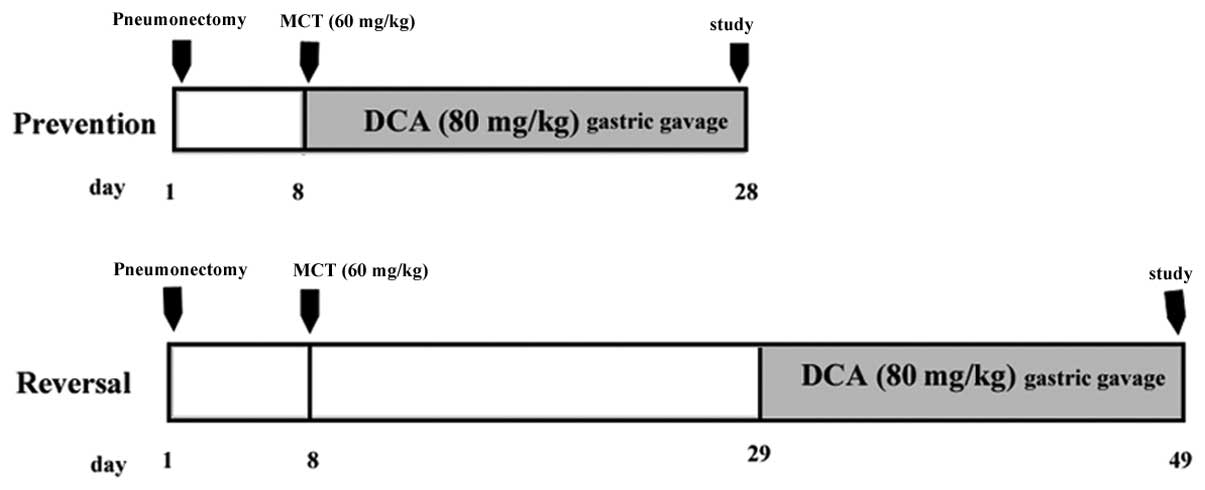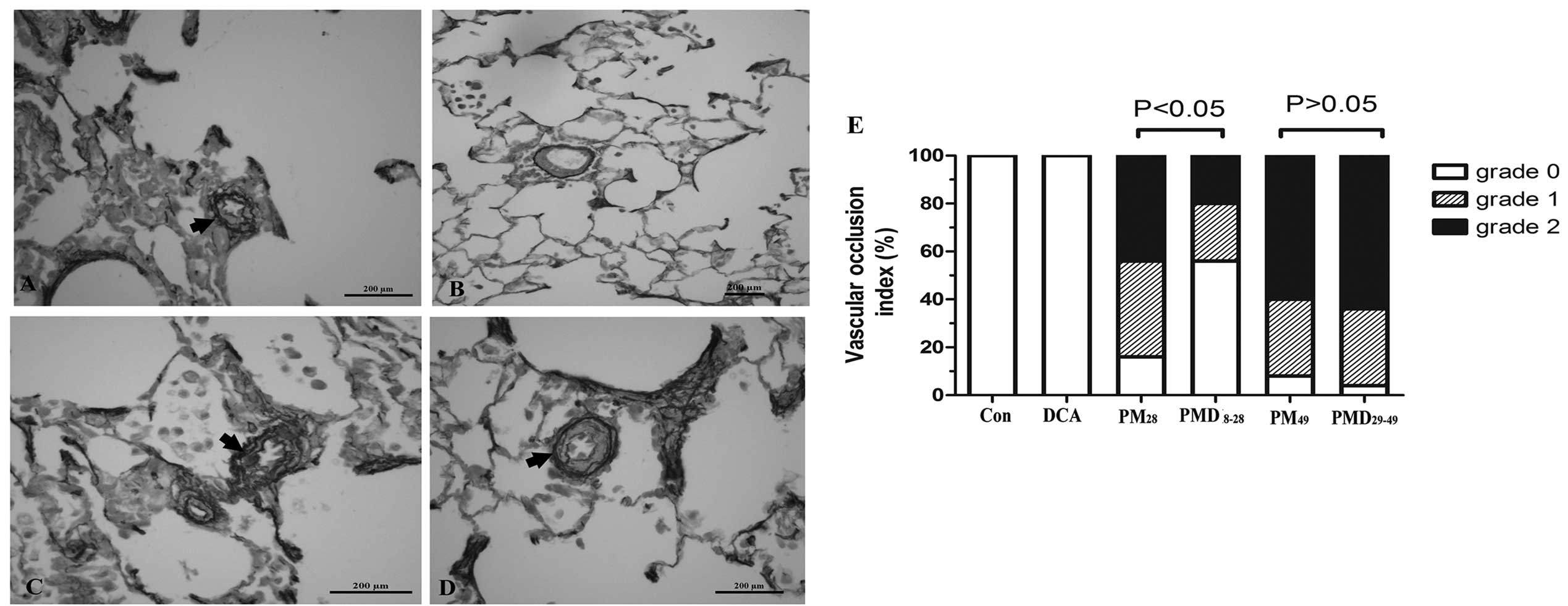|
1
|
McLaughlin VV, Davis M and Cornwell W:
Pulmonary arterial hypertension. Curr Probl Cardiol. 36:461–517.
2011. View Article : Google Scholar : PubMed/NCBI
|
|
2
|
Tuder RM: Pathology of pulmonary arterial
hypertension. Semin Respir Crit Care Med. 30:376–385. 2009.
View Article : Google Scholar
|
|
3
|
Stamm JA, Risbano MG and Mathier MA:
Overview of current therapeutic approaches for pulmonary
hypertension. Pulm Circ. 1:138–159. 2011. View Article : Google Scholar : PubMed/NCBI
|
|
4
|
Stacpoole PW, Nagaraja NV and Hutson AD:
Efficacy of dichloroacetate as a lactate-lowering drug. J Clin
Pharmacol. 43:683–691. 2003. View Article : Google Scholar : PubMed/NCBI
|
|
5
|
McMurtry MS, Bonnet S, Wu X, Dyck JR,
Haromy A, Hashimoto K, et al: Dichloroacetate prevents and reverses
pulmonary hypertension by inducing pulmonary artery smooth muscle
cell apoptosis. Circ Res. 95:830–840. 2004. View Article : Google Scholar : PubMed/NCBI
|
|
6
|
Michelakis ED, McMurtry MS, Wu XC, Dyck
JR, Moudgil R, Hopkins TA, et al: Dichloroacetate, a metabolic
modulator, prevents and reverses chronic hypoxic pulmonary
hypertension in rats: role of increased expression and activity of
voltage-gated potassium channels. Circulation. 105:244–250. 2002.
View Article : Google Scholar
|
|
7
|
Guignabert C, Tu L, Izikki M, Dewachter L,
Zadigue P, Humbert M, et al: Dichloroacetate treatment partially
regresses established pulmonary hypertension in mice with
SM22alpha-targeted overexpression of the serotonin transporter.
FASEB J. 23:4135–4147. 2009. View Article : Google Scholar
|
|
8
|
Michelakis ED, Webster L and Mackey JR:
Dichloroacetate (DCA) as a potential metabolic-targeting therapy
for cancer. Br J Cancer. 99:989–994. 2008. View Article : Google Scholar : PubMed/NCBI
|
|
9
|
Wong JY, Huggins GS, Debidda M, Munshi NC
and De Vivo I: Dichloroacetate induces apoptosis in endometrial
cancer cells. Gynecol Oncol. 109:394–402. 2008. View Article : Google Scholar : PubMed/NCBI
|
|
10
|
Washington JT and Quintyne NJ:
Dichloroacetate induces different rates of cell death in cancer and
noncancer cell lines in vitro. Tumori. 98:142–151. 2012.PubMed/NCBI
|
|
11
|
Saed GM, Fletcher NM, Jiang ZL, Abu-Soud
HM and Diamond MP: Dichloroacetate induces apoptosis of epithelial
ovarian cancer cells through a mechanism involving modulation of
oxidative stress. Reprod Sci. 18:1253–1261. 2011. View Article : Google Scholar : PubMed/NCBI
|
|
12
|
Semenza GL: Involvement of
hypoxia-inducible factor 1 in pulmonary pathophysiology. Chest.
128(Suppl): 592S–594S. 2005. View Article : Google Scholar : PubMed/NCBI
|
|
13
|
Tuder RM, Chacon M, Alger L, Wang J,
Taraseviciene-Stewart L, Kasahara Y, et al: Expression of
angiogenesis-related molecules in plexiform lesions in severe
pulmonary hypertension: evidence for a process of disordered
angiogenesis. J Pathol. 195:367–374. 2001. View Article : Google Scholar
|
|
14
|
Yan J, Shen Y, Wang Y and Li BB: Increased
expression of hypoxia inducible factor-1α in proliferating
neointimal lesions in a rat model of pulmonary arterial
hypertension. Am J Med Sci. 345:121–128. 2013.
|
|
15
|
Archer SL, Gomberg-Maitland M, Maitland
ML, Rich S, Garcia JG and Weir EK: Mitochondrial metabolism, redox
signaling, and fusion: a mitochondria-ROS-HIF-1alpha-Kv1.5
O2-sensing pathway at the intersection of pulmonary hypertension
and cancer. Am J Physiol Heart Circ Physiol. 294:H570–H578. 2008.
View Article : Google Scholar
|
|
16
|
Déry MA, Michaud MD and Richard DE:
Hypoxia-inducible factor 1: regulation by hypoxic and non-hypoxic
activators. Int J Biochem Cell Biol. 37:535–540. 2005.PubMed/NCBI
|
|
17
|
Bonello S, Zähringer C, BelAiba RS,
Djordjevic T, Hess J, Michiels C, et al: Reactive oxygen species
activate the HIF-1alpha promoter via a functional NFkappaB site.
Arterioscler Thromb Vasc Biol. 27:755–761. 2007. View Article : Google Scholar : PubMed/NCBI
|
|
18
|
McMurtry MS, Archer SL, Altieri DC, et al:
Gene therapy targeting survivin selectively induces pulmonary
vascular apoptosis and reverses pulmonary arterial hypertention. J
Clin Invest. 115:1479–1491. 2005. View
Article : Google Scholar
|
|
19
|
Stenmark KR, Meyrick B, Galie N, Mooi WJ
and McMurtry IF: Animal models of pulmonary arterial hypertension:
the hope for etiological discovery and pharmacological cure. Am J
Physiol Lung Cell Mol Physiol. 297:L1013–L1032. 2009. View Article : Google Scholar : PubMed/NCBI
|
|
20
|
Sakao S, Tatsumi K and Voelkel NF:
Reversible or irreversible remodeling in pulmonary arterial
hypertension. Am J Respir Cell Mol Biol. 43:629–634. 2010.
View Article : Google Scholar : PubMed/NCBI
|
|
21
|
Okada K, Tanaka Y, Bernstein M, Zhang W,
Patterson GA and Botney MD: Pulmonary hemodynamics modify the rat
pulmonary artery response to injury. A neointimal model of
pulmonary hypertension. Am J Pathol. 151:1019–1025. 1997.PubMed/NCBI
|
|
22
|
Nishimura T, Vaszar LT, Faul JL, Zhao G,
Berry GJ, Shi L, et al: Simvastatin rescues rats from fatal
pulmonary hypertension by inducing apoptosis of neointimal smooth
muscle cells. Circulation. 108:1640–1645. 2003. View Article : Google Scholar : PubMed/NCBI
|
|
23
|
Faul JL, Nishimura T, Berry GJ, Benson GV,
Pearl RG and Kao PN: Triptolide attenuates pulmonary arterial
hypertension and neointimal formation in rats. Am J Respir Crit
Care Med. 162:2252–2258. 2000. View Article : Google Scholar : PubMed/NCBI
|
|
24
|
Madhok BM, Yeluri S, Perry SL, Hughes TA
and Jayne DG: Dichloroacetate induces apoptosis and cell-cycle
arrest in colorectal cancer cells. Br J Cancer. 102:1746–1752.
2010. View Article : Google Scholar : PubMed/NCBI
|
|
25
|
Bowers R, Cool C, Murphy RC, Tuder RM,
Hopken MW, Flores SC, et al: Oxidative stress in severe pulmonary
hypertension. Am J Respir Crit Care Med. 169:764–769. 2004.
View Article : Google Scholar : PubMed/NCBI
|
|
26
|
Bonnet S, Michelakis ED, Porter CJ,
Andrade-Navarro MA, Thébaud B, Haromy A, et al: An abnormal
mitochondrial-hypoxia inducible factor-1alpha-Kv channel pathway
disrupts oxygen sensing and triggers pulmonary arterial
hypertension in fawn hooded rats: similarities to human pulmonary
arterial hypertension. Circulation. 113:2630–2641. 2006. View Article : Google Scholar
|
|
27
|
Fijalkowska I, Xu W, Comhair SAA, Janocha
AJ, Mavrakis LA, Krishnamachary B, et al: Hypoxia
inducible-factor1alpha regulates the metabolic shift of pulmonary
hypertensive endothelial cells. Am J Pathol. 176:1130–1138. 2010.
View Article : Google Scholar : PubMed/NCBI
|
|
28
|
Dorfmüller P, Chaumais MC, Giannakouli M,
Durand-Gasselin I, Raymond N, Fadel E, et al: Increased oxidative
stress and severe arterial remodeling induced by permanent
high-flow challenge in experimental pulmonary hypertension. Respir
Res. 12:1192011.
|
|
29
|
Xu D, Guo H, Xu X, Lu Z, Fassett J, Hu X,
et al: Exacerbated pulmonary arterial hypertension and right
ventricular hypertrophy in animals with loss of function of
extracellular superoxide dismutase. Hypertension. 58:303–309. 2011.
View Article : Google Scholar
|
|
30
|
Brüne B and Zhou J: Nitric oxide and
superoxide: interference with hypoxic signaling. Cardiovasc Res.
75:275–282. 2007.PubMed/NCBI
|
|
31
|
Van Rheen Z, Fattman C, Domarski S, Majka
S, Klemm D, Stenmark KR, et al: Lung extracellular superoxide
dismutase overexpression lessens bleomycin-induced pulmonary
hypertension and vascular remodeling. Am J Respir Cell Mol Biol.
44:500–508. 2011.
|
|
32
|
BelAiba RS, Djordjevic T, Bonello S,
Flügel D, Hess J, Kietzmann T, et al: Redox-sensitive regulation of
the HIF pathway under non-hypoxic conditions in pulmonary artery
smooth muscle cells. Biol Chem. 385:249–257. 2004. View Article : Google Scholar : PubMed/NCBI
|
|
33
|
Görlach A, Diebold I, Schini-Kerth VB,
Berchner-Pfannschmidt U, Roth U, Brandes RP, et al: Thrombin
activates the hypoxia-inducible factor-1 signaling pathway in
vascular smooth muscle cells: Role of the p22(phox)-containing
NADPH oxidase. Circ Res. 89:47–54. 2001.PubMed/NCBI
|
|
34
|
Dahal BK, Kosanovic D, Kaulen C,
Cornitescu T, Savai R, Hoffmann J, et al: Involvement of mast cells
in monocrotaline-induced pulmonary hypertension in rats. Respir
Res. 12:602011. View Article : Google Scholar : PubMed/NCBI
|
















